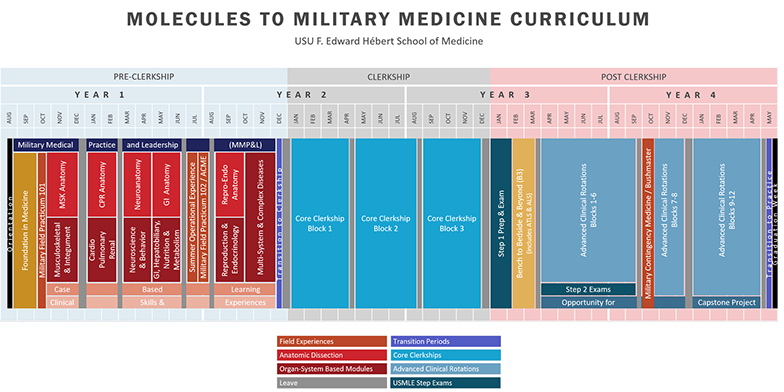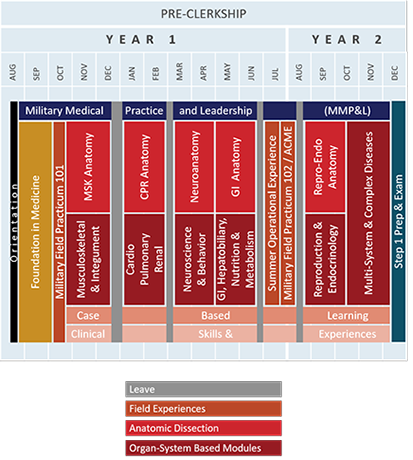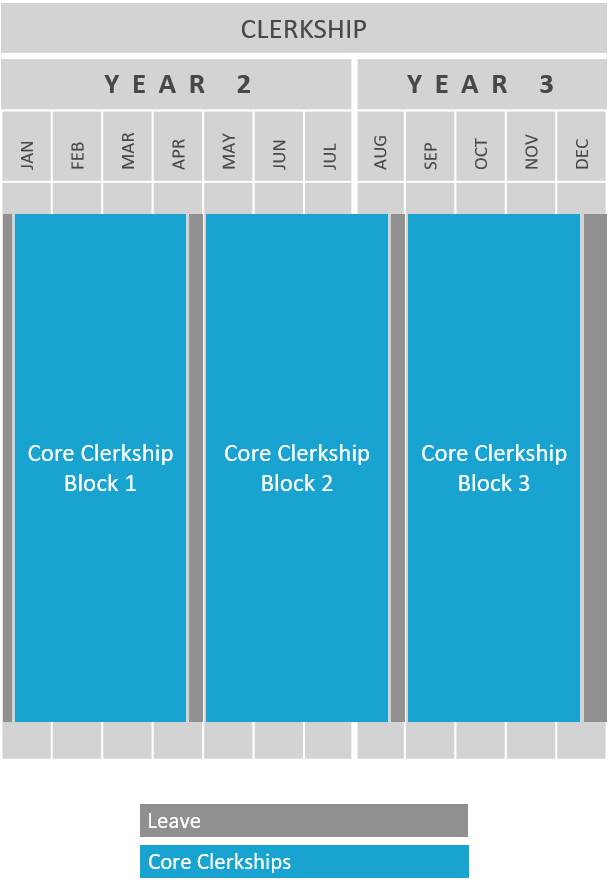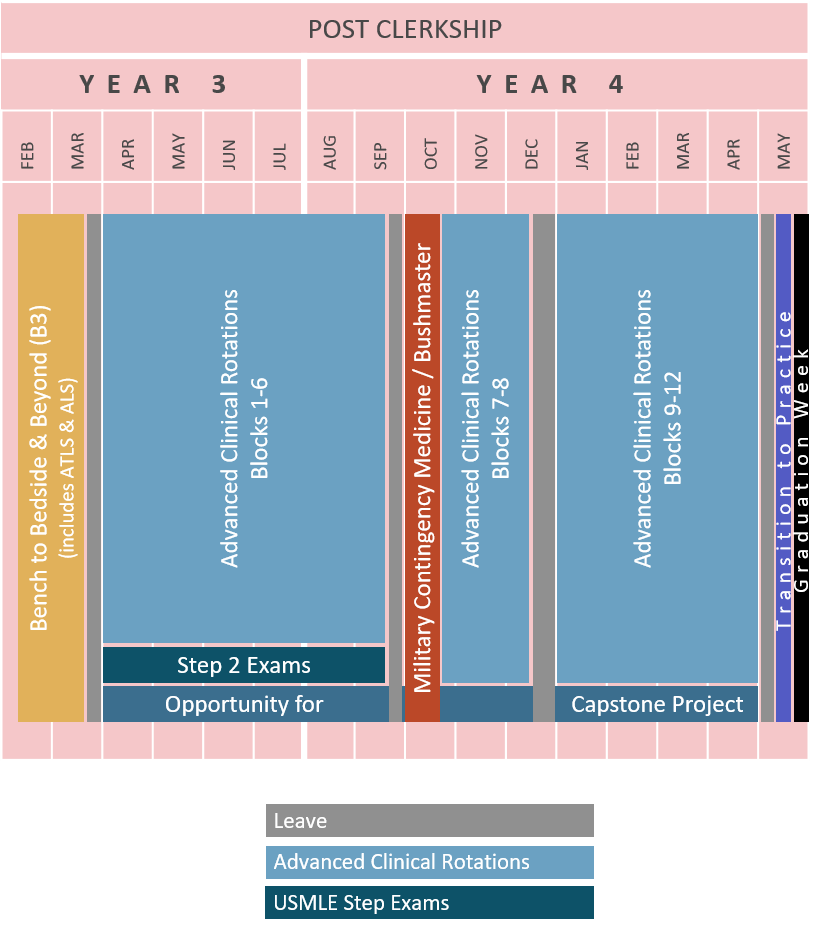PROGRAM DESCRIPTION
The MD program strives to instill an appreciation for the importance of scientific inquiry and the necessity for life-long learning, discovery, and self-improvement. It focuses on the theme of "Molecules to Military Medicine" and incorporates four conceptual pillars: integration of basic & clinical sciences throughout the entire four year curriculum, early patient contact, adaptability to unique learning styles, and the incorporation of advanced educational technologies. Rather than a discipline or course-based curriculum, USU has an integrated, system-based program which allows for medical science to be learned and applied in a clinical context. As a result, students begin interacting with and learning to care for patients within their first few weeks of class while studying and mastering those aspects of the basic sciences that represent the foundation of all medical education.
CURRICULUM
Molecules to Military Medicine
The overall curriculum is divided into three major segments: the pre-clerkship, clerkship, and post- clerkship periods, all of which incorporate specialized instruction and training related to the unique aspects of military medicine. The M2MM curriculum includes an even greater amount of time for senior electives, pre-Graduate Medical Education “audition rotations,” and advanced research opportunities.
The sixteen month pre-clerkship period begins with a seven-week “Foundation” module which introduces key concepts in basic science and clinical medicine, and allows students to acquire the tools to master the materials and develop the skills presented in six subsequent organ-system based modules: the Musculoskeletal and Integument module, the Cardiopulmonary-Renal module, the Neuroscience and Behavior module, the Gastrointestinal, Hepatobiliary, Metabolism and Nutrition module, and the Reproduction and Endocrinology module. The seventh and final module on Multisystem and Complex Diseases, prepares students to understand the intricacies of modern clinical medicine as they move into the next phase of their education: their clerkship year.
The pre-clerkship period enables students to establish a strong foundation in the basic science associated with the mechanisms of human disease, and the latest approaches to prevention and treatment. During this time, students begin developing their professional identities as officers and physicians, so they can fulfill the promise of duty and expertise to their future patients and military units. They are mentored by experienced faculty with an emphasis placed on the cultivation of professional values and the mastery of key elements of basic and clinical science. Students also study and acquire an understanding of the social and epidemiologic principles needed for effective patient care.
Following a week-long “Transition to Clerkship” course in which students are introduced to their roles and responsibilities associated with the inpatient and outpatient clinical environments, students participate in a total of 48 weeks of required clinical clerkships, which are accomplished in three sixteen week blocks. The blocks may be completed in any order, but each block involves completion of a paired set of clinical clerkships, that incorporate the integration of key clinical and basic science themes or “threads” (see Table below).
Core clerkships build on many of the basic science “threads” - the fundamental anatomic, physiologic and pathologic concepts that were introduced in the pre-clerkship modules. Clinical threads focus on topics of medical professionalism, ethics, patient safety, quality improvement, the skills necessary to practice lifelong learning, and on evidence-based medicine.
The major objectives of the post-clerkship period are to prepare students for graduate medical education (residency training), and to foster advanced clinical decision-making skills as students move from being able to Report and then Interpret information, to ultimately Manage and Educate patients in accordance with the synthetic “RIME” model of medical education.
The post-clerkship period includes dedicated study time for the Step 1 exam, followed by six weeks of advanced curricular instruction in the “Bench to Bedside and Beyond” (B3) module to further integrate basic science and clinical concepts in a more advanced context. Advanced Life Support (ALS) and Advanced Trauma Life Support (ATLS) training is included. Students then complete rotations where elective choices assist them in narrowing down their options for residency. Step 2 exams are also taken in this time frame.
Included in the post-clerkship period is an opportunity to complete a Capstone Project. Capstone is a longitudinal project involving scientific inquiry in an area of the student’s choosing. Capstone opportunities range from traditional basic science to integrative, operational, translational, or clinically oriented projects. Students completing Capstone projects are expected to devote up to three months of the post-clerkship period to this scientific pursuit.
PRE-CLERKSHIP (61 CREDITS)
PRC1001 Foundation in Medicine - 7 credits
PRC2001 Musculoskeletal/Integument - 8 credits
PRC2002 Cardiopulmonary/Renal - 9 credits
PRC2003 Neuroscience and Behavior - 8 credits
PRC2004 Gastrointestinal, Hepatobiliary, Metabolism & Nutrition - 8 credits
PRC2005 Reproduction and Endocrinology Module - 7 credits
PRC2006 Complex and Multi-System Diseases Module - 8 credits
PRC2007 Military Medical Practice (Includes Summer Operational Experience) - 6 credits
CLERKSHIP
Following a one-week orientation session in which students are introduced to their roles and responsibilities associated with the inpatient and outpatient clinical environments, they participate in a total of 48 weeks of required clinical clerkships, which are accomplished in three sixteen-week blocks. The blocks may be completed in any order, but each block involves completion of a paired set of clinical clerkships, that incorporate the integration of key clinical and basic science themes or “threads”. Learn more about clerkships >
Block 1
MD03001 Inpatient Medicine - XX credits
XXXXXXX Outpatient Medicine - XX credits
PS03001 Psychiatry - XX credits
Block 2
FM03001 Family Medicine - XX credits
PD03001 Pediatrics - XX credits
XXXXXXX Selective/EM/Neurology - XX credits
Block 3
SU03001 General Surgery - XX credits
XXXXXXX Surgical Specialties - XX credits
OB03001 Obstetrics and Gynecology - XX credits
POST CLERKSHIP
The first six weeks of the post-clerkship phase allow students time to prepare for successful completion of Step 1 of the USMLE exam. Students then have a six-week period of advanced curricular instruction entitled “Bench to Bedside and Beyond” (B3). B3 is an opportunity for students to further integrate basic science and clinical concepts in an advanced context. After B3, students complete rotations with prospective residency sites and further enhance clinical skills and opportunities. Offerings include medical and surgical, ambulatory and inpatient rotations, research electives, operational medicine electives, and traditional sub-internships. During this period, students complete Part 2 of their board examinations (USMLE Step 2 Clinical Skills and Clinical Knowledge).
(XXXXXXX) Bench to Bedside and Beyond
(XXXXXXX) Military Contingency Medicine
Required Advanced Clerkships
(XXXXXXX) Anesthesia
(XXXXXXX) Neurology
(XXXXXXX) Emergency Medicine
Required Sub-Internships (choose 2)
General Surgery
Family Medicine
Pediatrics
Psychiatry
Internal Medicine
And more
Selectives
Students have seven 'selective' blocks. Students who complete Anesthesia or Neurology as a Core Selective block have eight 'selective' blocks. There are many options for Selectives including traditional sub-internships, clinical electives, operational/humanitarian rotations, and/or specialized research (including a Capstone Project). Students are encouraged to complete an elective in behavioral health.
CAPSTONE PROJECT
As part of the post-clerkship period, students have the opportunity to complete a Capstone project. The Capstone is an optional program for students to complete before graduation that promotes self-directed discovery and advanced scientific inquiry as students progress through their MD program. Planning for the faculty-mentored project should begin prior to the post-clerkship period - with identification of a project mentor, discussions about study design, and securing of necessary approvals. A dedicated time slot of up to three months is allotted in the post-clerkship phase specifically to complete the Capstone project, which will be formally assessed.
These student-selected longitudinal projects include basic (bench) research, clinical research, education research, performance improvement studies, operational studies, and other public health projects. Projects proposed by students are considered on an individual basis, and planning is ongoing with students in their third and fourth year of study.
Capstone projects can range anywhere from one to three months in duration. Depending on student interests and/or type of Capstone project, work may start earlier and proceed in a contiguous or non-contiguous time frame.
UNITED STATES MEDICAL LICENSING EXAMINATION
In addition to fulfilling the academic and personal requirements to graduate from the School of Medicine, students must take and pass Step 1, Step 2-CK (Clinical Knowledge), and Step 2-CS (Clinical Skills Examination) of the United States Medical Licensing Examination (USMLE). All three parts of the examination are administered annually by the National Board of Medical Examiners (NBME).
Students are expected to take their Step 1 examination following the completion of their core clerkships. The Step 1 examination assesses whether medical students can apply important basic science concepts to the practice of medicine.
Step 2-CK is taken between April and September of the post-clerkship period and assesses whether students can apply the medical knowledge and clinical skills essential for the provision of patient care under supervision. It includes an emphasis on health promotion and disease prevention.
Step 2-CS is taken after Step 2-CK, and is to be completed by September of the post-clerkship period. Step 2-CS uses standardized patients to assess a medical student’s ability to gather information from patients, perform physical examinations, and communicate their findings. Fees for all parts of the USMLE are paid by USU.
These examinations are used by the school, along with other assessments, to determine cognitive mastery in a range of subject material. Performance on the USMLE is recorded on the student’s official transcript as pass/fail. Because the faculty regards the ability to pass all components of the USMLE as evidence of minimal competence, any student who fails either Step 1, Step 2-CK, and/or Step 2-CS, will be formally reviewed by the Student Promotions Committee.
FIELD EXERCISES
ANTIETAM
First-year medical students gain unique perspectives on the evolution of military medicine during the annual march across the Antietam National Battlefield, the bloodiest one-day battle in American history. Students tread six miles of these storied fields to learn about the medical advancements made and the obstacles military personnel faced when providing care during the Civil War.
ADVANCED COMBAT MEDICAL EXPERIENCE (ACME)
In the midst of battle, casualties have to be assessed and stabilized long before injured service members ever see a hospital. ACME develops and reinforces the knowledge, skills, and attitudes necessary to perform effective pre-hospital assessment and stabilization of combat wounded casualties.
OPERATION BUSHMASTER
Operation Bushmaster serves as the exam for the Military and Contingency Medicine course. Taking place on a simulated battlefield, the assessment covers a broad range of topics from advanced trauma life support to preventive medicine and patient care in flight to military medical ethics. Students live in field conditions and work in teams, rotating through positions as commanders, executive officers, medical officers, and ambulance team leaders. The assessment culminates in a mass casualty exercise in which an entire platoon is seriously injured where students must triage the wounded while arranging for their evacuation.
More information about Field Exercises >
APPLICATION REQUIREMENTS
Students must meet the following criteria to be eligible to apply to USU:
- Citizenship
- Age
- GPA
- Baccalaureate Degree
- Prerequisite Courses
APPLICATION PROCESS
You must first apply through AMCAS, then through USU. Once we have received confirmation of your application submission from AMCAS, we will email you information on how to submit your supplemental application. Please note that applications that do not come through AMCAS will not be considered.
AMCAS
Applicants must complete an application through the online American Medical College Application Service (AMCAS) at www.aamc.org.
Applicants who are selected for medical school interviews at USU will be invited to apply through the portal. Please note that applications that do not come through AMCAS will not be considered.
Applicants entering the program with regular status are expected to have completed course work required for a bachelor's degree in chemistry, cell biology, biochemistry, biophysics, genetics, molecular biology or microbiology.
Deadline
The AMCAS application period begins in late May and terminates on or before December 15 prior to the year in which the applicant anticipates enrollment.
USU APPLICATION
Once we have received confirmation of your application submission from AMCAS, we will send you an email with instructions for submitting the secondary application.
The USU Application requires:
- Medical College Admission Test (MCAT) Scores
- Letters of Recommendation
- Letter of Approval or Letter of Release (Current Military Only)
- Essay Questions
Application fee: $0
Deadline
We work on a rolling admissions basis. This means that an applicant's file is advanced onto the next phase as soon as the previous phase is completed. Failure to complete steps in a timely manner will delay the processing of an individual’s application. The process begins with an application to AMCAS. We advise applicants to apply in the June prior to the year of matriculation.
FINANCIALS
Tuition: $0
Fees: $0
Books: $0
Equipment: $0
Healthcare: $0
Housing allowance: ~$28k
Salary: ~$35k
Subsistence: ~$3k
Students pay no tuition or fees and receive the full salary and benefits of a uniformed O-1 officer throughout their four years at the university. Benefits include free medical care for students and eligible family members, a housing allowance, and 30 days paid leave annually. Books and laboratory equipment are also furnished to students at no charge.
Learn More About Pay & Benefits >
SERVICE REQUIREMENT
Students graduate debt free in exchange for an active duty service commitment upon graduating: seven years for Army, Navy, and Air Force, and ten years for Public Health Service. Upon acceptance, medical students commission as officers in one of the four uniformed services before beginning classes at the University. USU accepts active duty personnel, but no prior service is required for admission to USU.



